Stipend Committee, Academy C Representative
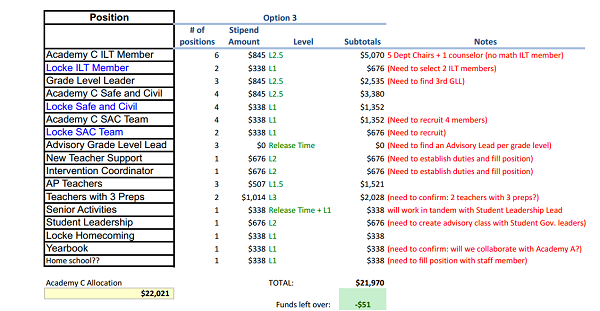
I. Overview
Why I chose this project
"The task of leadership is not to put greatness into people, but to elicit it, for the greatness is there already." -John Buchan
Project Plan
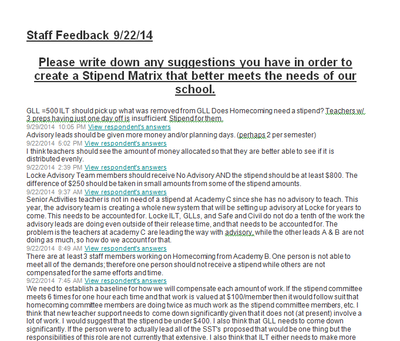
Summary
II. Main Activities
First Vote (10/17/14)

- Administration published the list of teacher leadership roles including job descriptions and list of responsibilities
- I collected quantitative and qualitative data regarding each role from teachers using surveys and interviews with staff members who have held such positions, focusing on whether the duties listed were accurate and roughly how much time was spend on each role on a weekly basis. I shared this data report on 9/23/14.
- The Stipend Committee representatives from each academy met several times in October to share data and collaboratively create a common Stipend Matrix for all sites at Locke
- On 10/17/14, I presented the Stipend Matrix Proposal to Academy C, and issued an electronic vote to approve or disapprove of the matrix with comments
- Results from each academies votes were compiled and sent to administration and staff.
- Teachers from all academies voted down the Stipend Proposal with the following vote:
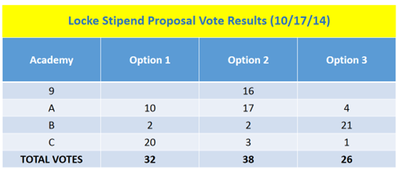
Second Vote (11/18/14)
- Stipend Committee representatives collected additional data on why the Stipend Proposal was denied and what suggested improvements would create a more agreeable arrangement.
- Stipend Committee then re-convened to adjust Stipend Matrix using feedback collected on 10/17/14 and additional feedback gathered since the vote.
- We decided to create stipend options that site members could select from, representing different priorities. Each Stipend Committee Representative shared one Stipend Proposal, then within the committee, we narrowed the options from 4 down to 2:
| Option 1 | Option 2 |
|
|
 |
- On 11/18/14, I presented the Stipend Proposal options 1 and 2 and issued an electronic vote.to select the preferred option or "none of the above."
- All staff at Locke ratified Option 2 with the following vote:
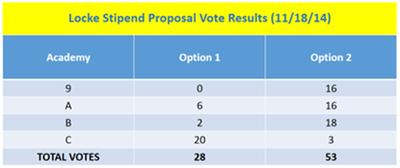
III. Reflection
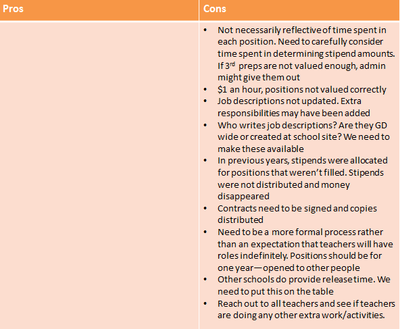
Challenges and Successes
Some challenges during the entire process included interfacing with all stakeholders at the appropriate times. It took us well over a month to publish each of the two votes because I had to gather data before and after school and during my prep period in addition to my regular duties as a teacher. Also, meeting with the Stipend Committee representatives on an as-needed basis was difficult to coordinate and required much time, so we ended up meeting on various mornings from 7am-8am. The most significant challenge, however, was creating a single Stipend Matrix that meets the needs of various sites simultaneously when in fact, each site has vastly different needs and a different context. For example, Note the absence of "pros" on the "pros/cons" feedback collected from staff above. Ultimately we were successful in creating a Stipend Matrix everyone agree upon, but only through much data gathering, collaborating, compromising, and ultimately lots of time and energy. However, the fact that we were able to successfully accomplish our task is a feat that I am very proud of, even if the ratified Stipend Matrix is less than perfect.
What I would do differently
What I would do differently next time, is to have an initial meeting with the Stipend Committee representatives to create a common plan of action detailing how we would all gather data from our staff. This process varied from site to site, and some sites had much more valuable information that others. Meeting to share ideas in this way would ensure that we are much better prepared to create an agreeable Stipend Matrix the first time around! Another aspect of stipends that are vital to the process is the idea of accountability. Many staff members had strong opinions about certain stipend roles and amounts based on how individuals performed those roles in previous years. We did our best to not let individual past performances affect decisions around stipends, and instead focused on the job descriptions and likely amount of time and effort required. However, staff needed to be reassured that teacher leaders were held accountable in some way to performing the listed duties and therefore deserved the listed stipends. Therefore in the future I would be clear to present what accountability for each role looks like so that this is not a confounding factor in agreeing upon a Stipend Matrix.
IV. Connection to the CAPEs (California Administrator Performance Expectations)

V. Supporting Documents
First Vote
- Teacher Leadership Positions and Duties (2014-2015)
- Academy C Initial Raw Data/Feedback re: Leadership Roles 9/22
- Academy C Data Report to Stipend Committee 9/23
- Stipend Proposal #1
- Academy C Vote - Results (10/17/14)
- Results of Vote Across Locke (10/17/14)


